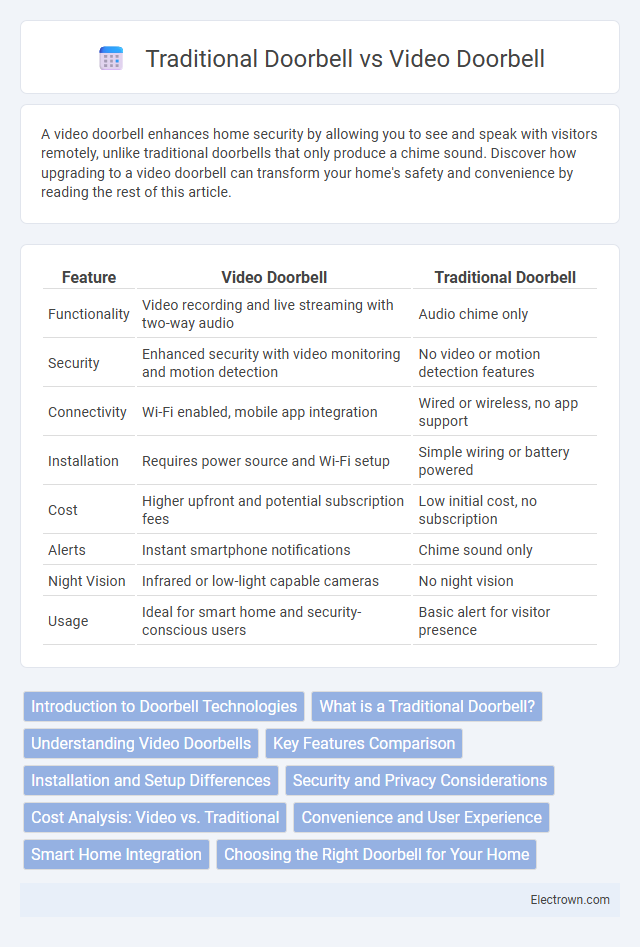A video doorbell enhances home security by allowing you to see and speak with visitors remotely, unlike traditional doorbells that only produce a chime sound. Discover how upgrading to a video doorbell can transform your home's safety and convenience by reading the rest of this article.
Table of Comparison
| Feature | Video Doorbell | Traditional Doorbell |
|---|---|---|
| Functionality | Video recording and live streaming with two-way audio | Audio chime only |
| Security | Enhanced security with video monitoring and motion detection | No video or motion detection features |
| Connectivity | Wi-Fi enabled, mobile app integration | Wired or wireless, no app support |
| Installation | Requires power source and Wi-Fi setup | Simple wiring or battery powered |
| Cost | Higher upfront and potential subscription fees | Low initial cost, no subscription |
| Alerts | Instant smartphone notifications | Chime sound only |
| Night Vision | Infrared or low-light capable cameras | No night vision |
| Usage | Ideal for smart home and security-conscious users | Basic alert for visitor presence |
Introduction to Doorbell Technologies
Video doorbells integrate digital cameras and internet connectivity to provide real-time video and audio communication, enhancing home security. Traditional doorbells rely on simple electrical circuits that trigger chimes or bells without visual or interactive features. Your choice between these technologies depends on the level of security, convenience, and remote access you require.
What is a Traditional Doorbell?
A traditional doorbell is a simple electrical device typically consisting of a button and a chime unit that produces a ringing sound when pressed. It operates through a direct wiring system connected to the home's electrical circuit, lacking video or smart features. These basic doorbells provide an audible alert without visual identification or remote access capabilities found in modern video doorbells.
Understanding Video Doorbells
Video doorbells integrate HD cameras, two-way audio, and motion sensors to enhance home security by allowing real-time monitoring and communication through smartphone apps. Unlike traditional doorbells that simply chime when pressed, video doorbells provide live video feeds and recorded footage, enabling homeowners to see and interact with visitors remotely. Advanced features such as night vision, cloud storage, and smart home integration make video doorbells a comprehensive security solution beyond the capabilities of conventional doorbells.
Key Features Comparison
Video doorbells offer real-time video monitoring, motion detection, and two-way audio, enhancing home security by allowing you to see and communicate with visitors remotely. Traditional doorbells provide basic audible alerts without visual or interactive features, relying solely on sound to notify occupants. The integration of smart technology in video doorbells significantly improves convenience and security compared to the simplicity of traditional doorbells.
Installation and Setup Differences
Video doorbells require a more complex installation process, involving Wi-Fi connectivity, smartphone integration, and sometimes existing doorbell wiring compatibility. Traditional doorbells typically have a straightforward installation with basic wiring to a chime and do not require network setup or app configuration. Video doorbells also demand regular updates and may need power adapters or battery replacements, unlike the mostly maintenance-free traditional doorbells.
Security and Privacy Considerations
Video doorbells enhance security by providing real-time video monitoring and recording, allowing you to see and communicate with visitors remotely, which helps deter potential intruders. Traditional doorbells lack this capability, offering only a chime without any video or audio surveillance, making it challenging to verify visitors before answering. Privacy concerns arise with video doorbells due to continuous recording and cloud data storage, necessitating careful review of device policies and security features to protect your personal information.
Cost Analysis: Video vs. Traditional
Video doorbells typically range from $100 to $300, offering integrated features such as HD video, motion detection, and smartphone connectivity, whereas traditional doorbells generally cost between $20 and $50 with basic chime functionality. Installation for video doorbells may incur additional expenses due to wiring or Wi-Fi setup, while traditional doorbells have lower installation costs and simpler hardware requirements. Long-term costs also include potential subscription fees for video storage and monitoring services, which are absent in traditional doorbell systems.
Convenience and User Experience
Video doorbells enhance convenience by allowing you to see and communicate with visitors remotely via smartphone apps, providing real-time alerts and maintaining a visual record. Traditional doorbells offer a simple auditory alert, but lack the interactive and security features found in video models. Your user experience improves with video doorbells through added control, security, and seamless integration with smart home systems.
Smart Home Integration
Video doorbells offer seamless smart home integration by connecting directly to Wi-Fi networks and mobile devices, enabling real-time video streaming and remote access. Traditional doorbells lack these capabilities, operating solely as wired chimes without interactive or monitoring features. The ability of video doorbells to integrate with platforms like Alexa, Google Assistant, and Apple HomeKit enhances security and convenience for modern smart homes.
Choosing the Right Doorbell for Your Home
Video doorbells enhance home security by allowing real-time video monitoring and two-way audio communication, making them ideal for tech-savvy homeowners. Traditional doorbells provide a simple and reliable alert system with minimal installation complexity and no ongoing maintenance costs. Evaluating factors like security needs, budget, and desired features helps determine whether a video doorbell or traditional doorbell suits your home best.
Video Doorbell vs Traditional Doorbell Infographic

 electrown.com
electrown.com